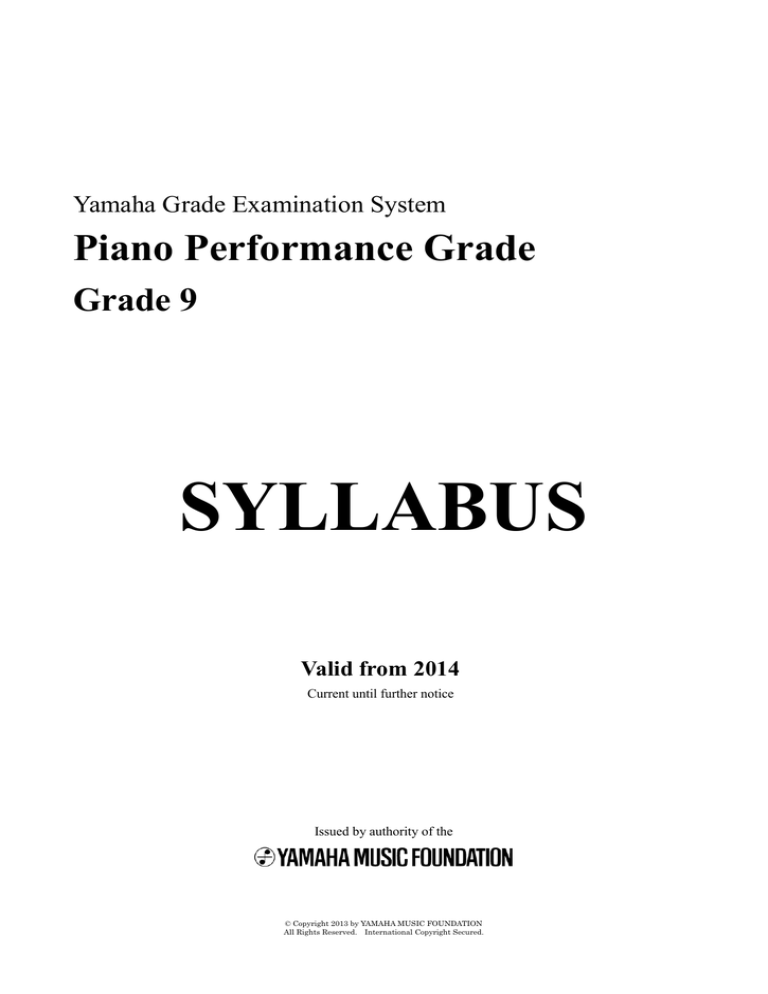
Yamaha Grade Examination System
Piano Performance Grade
Grade 9
SYLLABUS
Valid from 2014
Current until further notice
Issued by authority of the
© Copyright 2013 by YAMAHA MUSIC FOUNDATION
All Rights Reserved. International Copyright Secured.
Yamaha Piano Performance Grade 9 Syllabus (2014-2016)
2013.10
PREFACE
Yamaha Music Foundation is an organization established by the authority of
Japanese Ministry of Education, Culture, Sports, Science and Technology
for the purpose of promoting music education and music popularization. Its
unique, systematic teaching method and teacher training programs are
highly evaluated not only in Japan but also in other countries.
The Yamaha Grade Examination System has been developed to enable
students and teachers to ensure their own progress and thereby obtain
self-confidence in their own music studies.
The contents of Piano Performance Grade 10-6 examinations are designed
to cover various kinds of elements of musical knowledge and indicate the
direction that the students should follow.
The result of the examination will help the applicants to acquire the richer
ability of music.
The YAMAHA GRADE EXAMINATION SYSTEM consists of thirteen
grade levels, Grade 13 to Grade 1. The Examination evaluates the
performing ability of the music lovers in general; the performing ability and
the musical knowledge and techniques required for the instructors of the
fundamentals stage; and also the performing competence of the professional
musicians.
Both Piano and Electone Performance Grades are held from Grade 13 to
Grade 3. Grade 13 to Grade 6 are for the musical lovers and the students of
music schools; Grade 5 to Grade 3 are the professional grades for those who
intend to be the instructors. Fundamentals Grades are also in the higher
stage for instructor qualification which requires comprehensive musical
knowledge and performance. Those who intend to be instructors of Yamaha
Music Education System must obtain Grade 5 or higher in either Piano or
Electone Performance Grade and the Fundamentals Grade as well.
2
Yamaha Piano Performance Grade 9 Syllabus (2014-2016)
2013.10
Yamaha Grade Examination System
Piano Performance Grade 9
EXAMINATION PROCEDURE
Free Selection
Sight Playing
Accompaniment
Hearing
Comment
I. FREE SELECTION
Candidates prepare three pieces from Yamaha Music Education System’s textbooks, Piano Method (Masterpieces)
Grade 9 Vol.1-3*, Piano Method (Original Works) Grade 9** or any pieces that are the same difficulty level.
One candidate’s own composition can be included instead.
Candidates will be asked to play two chosen by the examiners from the pieces prepared.
Note:
- Pieces should be chosen carefully from variety of composers, eras countries, styles, forms etc. in order to
present a balanced program.
- Etudes and exercise pieces are basically not suitable for Free Selection. However, etudes that have high
musical value may be chosen. Candidates and the teachers should use their discretion in the choice.
- A suite, sonatina etc. will be counted as one piece even if candidate plays one or all of the pieces
(movements).
- Candidates are recommended to bring scores of the pieces prepared. Examiners may use when giving
comments.
- Performing from memory is optional but advisable.
- With regard to Repeat marks, follow the guidelines as below;
a) Sonata, Sonatina etc. --- without repeat
b) Pieces that the musical meaning can be expressed even if without repeat --- without repeat
c) Pieces that the repeat is needed to be musical --- with repeat
Follow the instruction from the examiners if you are not sure whether you should omit repeat.
* **Published by Yamaha Music Media Co., Ltd.
3
Yamaha Piano Performance Grade 9 Syllabus (2014-2016)
2013.10
II. SIGHT PLAYING
Candidates play at sight a piano piece of around eight bars in length.
Range of keys and times:
Keys:
C, G, F majors, A, D minors
Times: 4/4, 3/4
Example
Procedure
1. Candidates look through the score for approximately 30 seconds.
2. Candidates play the piece at sight after examiner’s cue,.
III. ACCOMPANIMENT
Candidates play suitable chords with both hands to a melody of around eight bars in length. The melody is from a
well-known piece, e.g. worldwide folk song.
Range of keys, times and chord
Keys:
C, G, F majors, A, D minors
Times: 4/4, 3/4
Chords: I, IV, V, V7 (root position)
Example
4
Yamaha Piano Performance Grade 9 Syllabus (2014-2016)
2013.10
Procedure
1. Candidates listen to the melody the examiner plays, while looking through the score.
2. Candidates play the most suitable chords that are based on the given bass notes with both hands, to the
melody the examiner plays.
3. Then candidates play the chords again in an appropriate accompaniment style.
Note:
- Bass notes will be given. So consider the suitable chords while referring them to.
- Candidate should use their discretion in the choice of accompaniment style so that it can be suitable for the
melody.
5
Yamaha Piano Performance Grade 9 Syllabus (2014-2016)
2013.10
IV. HEARING
Candidates play by ear melody/chords the examiner plays.
A. Melody Hearing
Candidates play by ear a melody of around four bars, played with the accompaniment.
Range of keys and times
Keys:
C, G, F majors, A, D minors
Times: 4/4, 3/4
Example
Procedure
1. The examiner tells candidates the key, and plays the whole melody with the accompaniment.
2. The examiner plays the first half, and then candidates play by ear the melody to the accompaniment played by
the examiner after examiner’s cue.
3. Then, the second half in the same manner.
6
Yamaha Piano Performance Grade 9 Syllabus (2014-2016)
2013.10
B. Harmony Hearing
Candidates play by ear a chord cadence of around four-six bars.
Range of keys, times and chords
Keys:
C, G, F majors, A, D minors
Chords: I, IV, V, V7 (root position)
Example
Procedure
1. The examiner tells candidates the key, and then plays all chords.
2. Then candidates play them after examiner’s cue.
7


